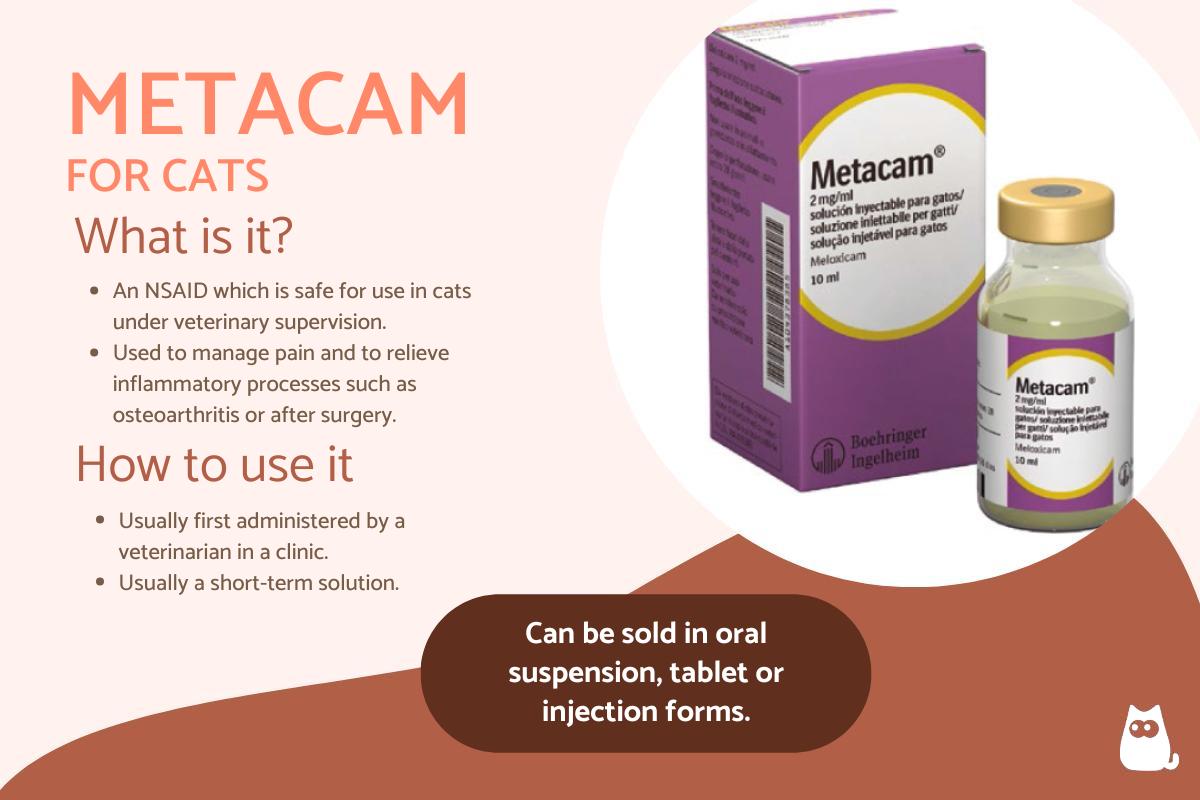Metacam for Cats - Dosage, Uses and Side Effects



See files for Cats
Metacam is the trade name of the drug whose active ingredient is meloxicam. This compounds belongs to the group of non-steroidal anti-inflammatory drugs (NSAIDs) that provides analgesic, anti-inflammatory and antipyretic effects. This menas the uses of Metacam for cats include treating postoperative pain, improving musculoskeletal problems and relieving inflammatory processes. AnimalWised explains more about Metacam for cats dosage, usage, side effects and more, including shelf life and price.
What is Metacam for cats?
Metacam is the trade name of a drug with the active ingredient known as meloxicam. This is a non-steroidal anti-inflammatory drug (NSAID) from the oxicam group. This drug is distinguished by its ability to inhibit the synthesis of prostaglandins through the action of cyclooxygenase enzymes. These are the enzymes responsible for producing them via the oxidation of arachidonic acid.
In particular, Metacam and other meloxicam drugs inhibit cyclooxygenase-2 (COX-2) more intensely than cyclooxygenase-1 (COX-1), the latter being more involved in maintaining renal blood flow and protecting the intestinal mucosa. While NSAIDs are often contraindicated in felines, meloxicam for cats is regularly prescribed by veterinarians for various uses. This is because mainly inhibiting COX-2, the risk of gastrointestinal, hepatic or renal side effects is reduced, while still effectively controlling mediators of fever, inflammation and pain.
Learn more about why cats are not normally prescribed NSAIDs with our article asking is carprofen for cats safe?

Metacam for cats uses
As with all NSAIDs, the main uses of Metacam for cats treat the symptoms of pain and inflammation. Specifically, it is very effective in controlling mild to moderate pain, especially after orthopedic and soft tissue surgery procedures, such as spaying or ovariohysterectomy in females.
Metacam is also widely used to relieve inflammatory processes in cats and for pain management in musculoskeletal disorders, both acute and chronic.
With this in mind, we can say Metacam uses for cats include the following:
- Post-operative pain: often used after spaying or neutering surgeries, but may also be useful for almost any type of surgical intervention.
- Arthritis: particularly in older dogs suffering from osteoarthritis or other joint inflammation.
- Other inflammatory processes: especially those caused by bacterial, viral, fungal or even parasitical infections.
- Chronic pain management: although relatively safe in cats, Metacam is not normally used for long-term pain issues, but it may be useful when the treatment is palliative.
Metacam for cats dose
Metacam use usually begins with an injectable application of Metacam 2 mg/ml at a dose of 0.1 ml/kg of body weight. Twenty-four hours after the injection, Metacam is administered orally in its 0.5 mg/ml suspension form, at a dose of 0.05 mg meloxicam/kg of body weight every 24 hours until the pain and inflammation are controlled.
If oral suspension is chosen from the start, the initial dose will be 0.1 mg meloxicam/kg of body weight for chronic musculoskeletal disorders and 0.2 mg meloxicam/kg of body weight for acute musculoskeletal disorders. In both cases, a maintenance dose of 0.05 mg meloxicam/kg of body weight is continued every 24 hours until inflammation and pain resolve.
Typically, the duration of treatment with Metacam in cats is about one week. It is not recommended to extend the use of the drug beyond 14 days if no clinical improvement is observed. The Metacam for cats dosage we have shared is only a guideline and the correct treatment for your cat's specific needs can only be prescribed by a veterinarian.
Learn about the dosage and administration of itraconazole for cats with our related guide.

How to administer Metacam for cats
We have already discussed the doses of Metacam for cats, both the maintenance and the initial dose. This dosage is dependent on the medication used and the disorder to be treated. The injectable form must be administered by the veterinarian through a subcutaneous injection in the feline, while Metacam in oral suspension can be administered at home by the cat's guardians. This can be either directly into the cat's mouth or mixed into their food.
Metacam for cats price
The price of Metacam will depend on the quantity in the bottle, the format, the brand and the pharmacy where it is purchased. Country or region of purchase are also important factors since medications vary greatly according to location. Generally speaking, a 15 ml bottle of Metacam oral suspension will cost around $30-$50.
Metacam for cats shelf life
How long any medication will last in your medicine cabinet and remain useful will vary. The drug may still be effective, but lose potency. Others may increase the likelihood of adverse side effects. The shelf life of Metacam for cats depends on its preparation:
- Oral suspension: will have a ‘Use By’ date, but it will typically have a shelf life of around 6 months once opened.
- Tablets: tablets also have a ‘Use By’ date, but typically last longer than oral suspension at around 1-3 years.
- Injectable solution: can remain viable for around 2-3 years, but should be used within 28 days once opened.
Read about another medication available in both oral and injectable solutions with our article on interferon for cats.
Side effects of Metacam for cats
As with any other medication, Metacam for cats can cause adverse effects or undesirable reactions. Being an NSAID, typical side effects of this type of drug have been recorded. They include:
- Vomiting
- Diarrhea
- Apathy
- Blood in stool
- Loss of appetite
- Gastrointestinal ulcers
- Elevation of liver enzymes
- Kidney failure
It is important to note that most of these side effects are usually temporary and disappear when treatment ends. If we do observe any negative side effects in our cat, contact a veterinarian immediately.
Learn about other causes of blood in cat feces with our related article.

Contraindications of Metacam for cats
Finally, Metacam for cats has several contraindications. Its use should be avoided in various situations, so it should be avoided in:
- Lactating or pregnant cats
- Cats with liver, kidney or heart disease
- Cats with known hypersensitivity or allergy to meloxicam or any of the excipients of the medication
- Kittens under six weeks of age
- Cats that are hypovolemic, hypotensive or dehydrated (due to the risk of renal toxicity)
- Cats with gastrointestinal problems accompanied by bleeding or irritation
- Cats with blood disorders
- Cats taking other NSAIDs, anticoagulants, diuretics, antibiotics from the aminoglycoside group
- Cats taking substances with high affinity for proteins or with nephrotoxic potential
Learn about another NSAID which can be taken by felines with our article on what is Onisor for cats?
This article is purely informative. AnimalWised does not have the authority to prescribe any veterinary treatment or create a diagnosis. We invite you to take your pet to the veterinarian if they are suffering from any condition or pain.
If you want to read similar articles to Metacam for Cats - Dosage, Uses and Side Effects, we recommend you visit our Medicine category.








